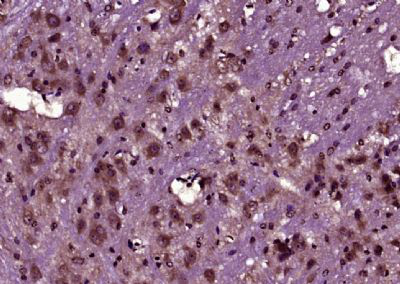产品货号 : mlR8059
英文名称 : KIAA1199
中文名称 : 跨膜蛋白2样蛋白抗体
别 名 : TMEM2L; IR2155535; KIAA1199 protein; CEMIP; CCSP1; CEMIP_HUMAN; Cell migration-inducing and hyaluronan-binding protein.
研究领域 : 肿瘤 细胞生物 免疫学 神经生物学
抗体来源 : Rabbit
克隆类型 : Polyclonal
交叉反应 : Human, Mouse, Rat, Chicken, Dog, Cow, Horse, Rabbit,
产品应用 : ELISA=1:500-1000 IHC-P=1:400-800 IHC-F=1:400-800 IF=1:100-500 (石蜡切片需做抗原修复)
not yet tested in other applications.
optimal dilutions/concentrations should be determined by the end user.
分 子 量 : 109/150kDa
细胞定位 : 细胞核 细胞浆 细胞膜 细胞外基质 分泌型蛋白
性 状 : Lyophilized or Liquid
浓 度 : 1mg/ml
免 疫 原 : KLH conjugated synthetic peptide derived from human TMEM2L/KIAA1199:101-200/1361
亚 型 : IgG
纯化方法 : affinity purified by Protein A
储 存 液 : 0.01M TBS(pH7.4) with 1% BSA, 0.03% Proclin300 and 50% Glycerol.
保存条件 : Store at -20 °C for one year. Avoid repeated freeze/thaw cycles. The lyophilized antibody is stable at room temperature for at least one month and for greater than a year when kept at -20°C. When reconstituted in sterile pH 7.4 0.01M PBS or diluent of antibody the antibody is stable for at least two weeks at 2-4 °C.
PubMed : PubMed
产品介绍 : TMEM2L belongs to the TMEM2 family and contains 4 PbH1 repeats. It is expressed in the inner ear. It is expressed in cochlea and vestibule tissues and it may be involved in hearing. Defects in KIAA1199 may be a cause of non-syndromic hearing loss. It is also thought that KIAA1199 is a tumor suppressor that may be involved in establishing cellular mortality in normal human cells.
Function:
Mediates depolymerization of hyaluronic acid (HA) via the cell membrane-associated clathrin-coated pit endocytic pathway. Binds to hyaluronic acid. Hydrolyzes high molecular weight hyaluronic acid to produce an intermediate-sized product, a process that may occur through rapid vesicle endocytosis and recycling without intracytoplasmic accumulation or digestion in lysosomes. Involved in hyaluronan catabolism in the dermis of the skin and arthritic synovium. Positively regulates epithelial-mesenchymal transition (EMT), and hence tumor cell growth, invasion and cancer dissemination. In collaboration with HSPA5/BIP, promotes cancer cell migration in a calcium and PKC-dependent manner. May be involved in hearing.
Subunit:
Interacts with EPHA2 and ITPR3. Interacts with HSPA5/BIP; the interaction induces calcium leakage from the endoplasmic reticulum and cell migration. Interacts with clathrin heavy chain/CLTC.
Subcellular Location:
Nucleus. Cytoplasm. Endoplasmic reticulum. Cell membrane. Membrane, clathrin-coated pit. Secreted. Note=Retained in the endoplasmic reticulum (ER) in a HSPA5/BIP-dependent manner. Colocalized with clathrin heavy chain/CLTC in clathrin-coated vesicles. Strongly detected in the cytoplasm of breast carcinoma cells, whereas poorly detected in adjacent normal epithelial cells, stromal cells, or benign breast tissues. Localized in the nucleus and cytoplasm of colon adenocarcinomas.
Tissue Specificity:
Expressed in dermal and in synovial fibroblasts. Strongly expressed in gastric cancers compared with the paired normal tissues. Strongly expressed in both ductal carcinoma and invasive breast cancer cells compared with benign epithelial cells (at protein level). Strongly expressed in brain, placenta, prostate, breast, lung and testis. Expressed in fibroblasts, epithelial cells and cancer cells. In ear, it is specifically expressed in inner ear. Expressed in cochlea and vestibule tissues. Strongly expressed in gastric cancers compared with the paired normal tissues. Strongly expressed in colon adenocarcinomas compared with normal colonic mucosas. Strongly expressed in breast cancer as compared to normal breast tissue.
Post-translational modifications:
N-glycosylated; glycosylation is not necessary for HA-binding.
Similarity:
Belongs to the TMEM2 family.
Contains 1 G8 domain.
Contains 4 PbH1 repeats.
SWISS:
Q8WUJ3
Gene ID:
57214
Important Note:
This product as supplied is intended for research use only, not for use in human, therapeutic or diagnostic applications.
产品图片










